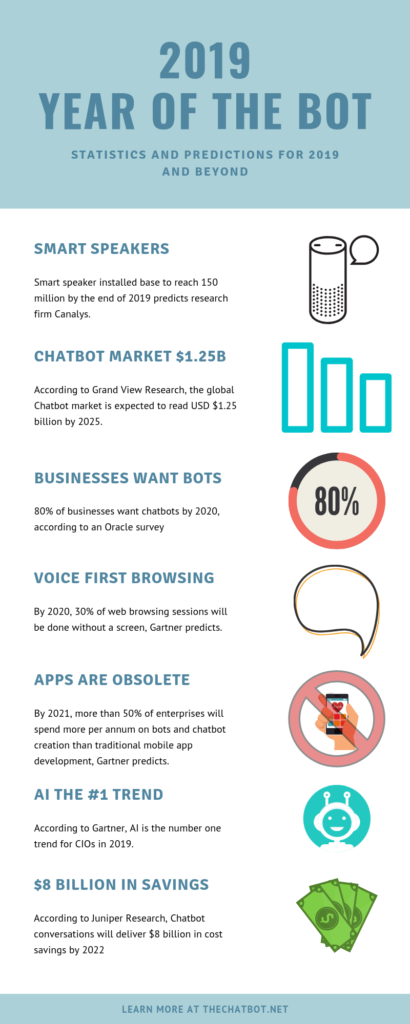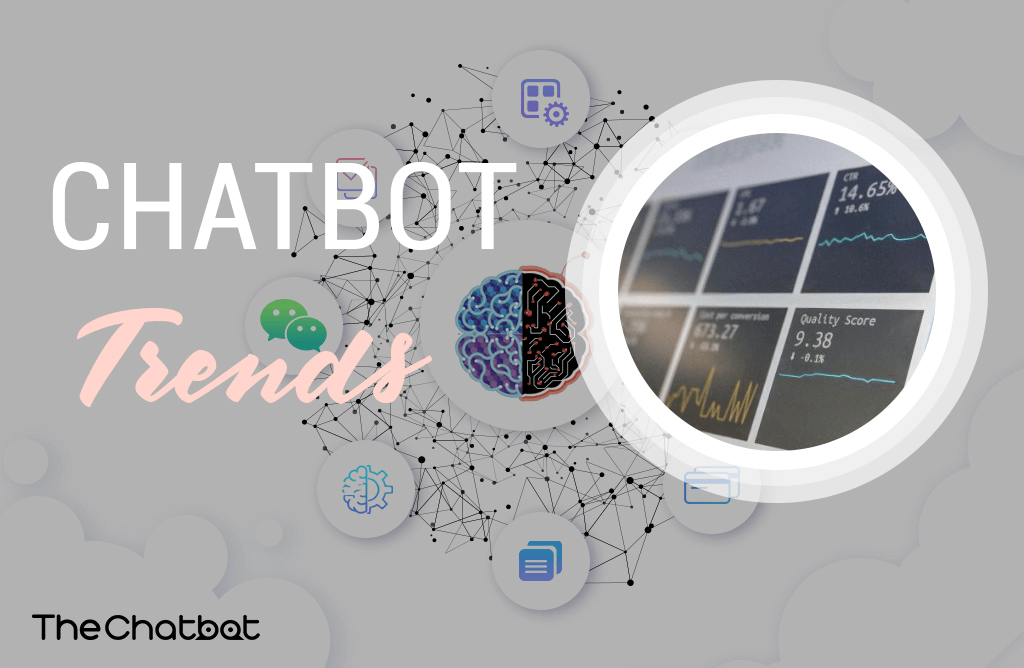Winter sees businesses digging into their data stores to drop some impressive graphs of where tech is headed, while journalists and analysts ponder on the next big things for their end of year articles. Here’s a combined look at where chatbots, AI and virtual assistants fit into the big scheme of things.
Predictions for the AI Era Strengthen
DXC has a firm grasp on how technology impacts business and one of its top six trends for 2019 focuses on the dawn of an age of information enlightenment. Their advisors believe “AI will come of age as it gets baked into applications. Whereas ML produces a result based on historical data it has learned from, AI can provide an intelligent response. ML might tell you that Sue typically takes three days to review a report, whereas AI might send a report to Sue’s assistant because Sue is traveling and it will likely take her six days to review the report. AI takes what ML “knows,” factors in other information and exhibits intelligent behaviors.”
Following that trend, IT-focused analysts at Gartner reckon AI is the No. 1 trend for CIOs. they believe that “Data is the fuel that powers the IoT and the organization’s ability to derive meaning from it will define their long term success. AI will be applied to a wide range of IoT information, including video, still images, speech, network traffic activity and sensor data. The technology landscape for AI is complex and will remain so through 2023, with many IT vendors investing heavily in AI, variants of AI coexisting, and new AI-based tolls and services emerging.”
The Richards Group is famous for adding a little marketing and advertising spin on the usual end of year predictions. This year, among the road to 5G and social conversations, sees it looking at Getting Creative With Machine Learning. They highlight how common machine learning is, from Netflix and Amazon’s recommendations and how it can help advertisers refine their products and approaches through the power of machine learning. Using machine learning to help its clients better understand the technology and the nuances that AI can highlight, the whole 10-trend piece is an insightful read.
Forbes may be little more than clickbait these days, it even runs stories on the latest Fortnite updates. But it does run the odd useful piece, most recently, looking at tech trends in healthcare, via market research firm Frost and Sullivan. Its predictions are littered with AI and chatbot references, citing Healthcare as a dominant vertical in voice applications. It reckons, “Healthcare is at a tipping point with voice – specialized players such as Nuance, Orbita and leading tech companies (Amazon, Apple, Google, and Microsoft) are catching on with targeted voice technologies suited for healthcare industry use cases. We anticipate, though out 2019, HIPAA-compliant voice and chatbot applications for healthcare will gain prominence as these tech titans aggressively compete on voice solutions.”
Chatbot Trends and Stats for Chat and Assistant Technology
While the trends may prove true or not, hard statistics show that most of them are backed up by the numbers.
Smart speakers, the primary gateway for virtual assistants in the home are expected to be in over 100 million homes around the world, according to recent stats. That could well be higher based on the recent rampant Black Friday and Cyber Monday sales, with Amazon and others steeply cutting the prices of Echo and competing products like Google Home.
They also make a popular Christmas present, and are commonly bundled with sound bars, home smart lighting and other gadgets, which will see even more of them being set up among the tinsel to drive a fresh generation of people asking for a particular song or playing with the lights.
Once the novelty wears off, these services will be used for a growing range of uses, with search key among them, moving information off the screen. Researchers gauge that by 2020, 30% of web searches will be directed without contacting the screen. Half of these inquiries will be done through voice directions, creating new challenges and opportunities.
Across all these, the chatbot market size is estimated to hit $1.25 Billion By 2025, according to Grand View Research at a CAGR of 24.3%. That’s boosted by growth in the use of artificial intelligence, IoT, and APIs, among others that are evolving at a rapid speed.
Come January 2019, we should have a fresh collection of statistics and data to see just how and where the market for chatbots and AI is growing. artificial intelligence, IoT, and APIs, among others, are evolving at a rapid speed

The Future is bright for chatbots
More and more businesses are realizing the benefits of chatbots, either planning to or already investing heavily in development.
In 2016, Oracle conducted a survey of 800 decision makers from the United Kingdom, France, Africa and the Netherlands. This group consisted of chief marketing officers, senior sales execs, chief strategy officers, etc. Eighty percent of the respondents said that they had or intended to have chatbots by 2020. In addition, more than forty percent of the respondents believed that automation will improve the customer experience.
This data was part of an Oracle report called ‘Can Virtual Experiences Replace Reality?’ available for free from Oracle through the link. This report is a well produced 19 pages, with quite a bit of interesting data in it.
Gartner predicts that Bots Take Over
According to Gartner’s Top Strategic Predictions for 2018 and Beyond, by 2021 more than 50% of enterprises will spend more per annum on bots and chatbot creation than traditional mobile app development.
Gartner is predicting that the adaptability of chatbots will win out here. Of course, apps will remain one of many options for customers, alongside chatbots, websites and any other methods of customer communication.
Juniper Research expects massive cost savings
Banking and Finance are ideal markets for chatbots, according to a Juniper Research report. Enquiries in those industries are often simple and linear, things like ‘what is my balance?’
This will save 4+ minutes per call when compared to a traditional call center interaction, and an average of $0.70 per chatbot interaction in savings.
With that in mind, they have predicted that by 2022 chatbots will deliver $8 billion in savings from successful chatbot interactions.
This primarily comes from the rising success rate of interactions with Messaging-based Banking bots. That number was approximately 20% in 2017 and is predicted to hit 93% in 2022. With a 93% success rate the customer experience will be exemplary and it’s hard not to anticipate chatbots become like ATMs are to us today—much preferable to human interaction in simple cases.
But it’s not just successful interactions driving these savings. One of the properties of chatbots over human representatives is their responsiveness. When customer service is fast and hassle free, customer retention will be increased.
From rare to ubiquitous
The trend seems crystal clear. In the future we’ll all be interacting with chatbots a lot more than we might have predicted only a few years ago. They’ll be helping us with our banking. They’ll be helping us schedule appointments with our doctors and dentists.
Anywhere the interaction between the company and the customer is straightforward, you can expect them to be. As the technology improves, they will handle more and more complex interactions until finally it will be a rare case that your friendly chatbot can’t handle.
Like the smartphone before it, the chatbot will go from something rare to something ubiquitous in the blink of an eye.





3 responses to “2019 Trends & Stats Show Chatbots’ Place in a Wider AI World”
[…] bots are mostly focused on a particular goal, but chatbots with the best AI can do so much more than that. They can handle thousands of inquiries on a daily level while […]
[…] Oracle says, “80% of businesses want chatbots as they are beginning to see the benefits of using chatbots for their customer-based products.” But, are you implementing a chat solution just to be in the race? Or is there a difference between using Live Chat and Chatbot? […]
interesting